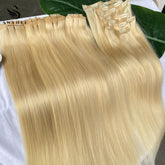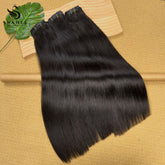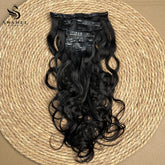Types of Hair Extensions and Foolproof Installation Techniques
Hair extensions are a great accessory for adding volume and/or length to hair. What’s cool about them is that they come in various textures, lengths, and colors, making them highly customizable. Additionally, when installed correctly, hair extensions can serve as a protective style, facilitating the growth of your natural hair.
Installing hair extensions requires a certain level of skill. Therefore, I recommend visiting a professional, or at least having someone experienced install them for you if it’s your first time. There are four main methods for installing hair extensions: Clip-in, Tape-in, Sew-in, and the Brazilian knot method. Let’s explore each one in more detail.
This method is likely the easiest way to install hair extensions. It’s crucial to purchase actual clip-in extensions, as regular weft hair or loose bundles won’t work. To install, simply part your hair into horizontal sections and attach the clips where desired.
- Pros: Quick installation and easy removal.
- Cons: Prone to falling out.
The tape-in method is straightforward but comes with risks. First, part your hair horizontally and gather the excess hair into a neat bun. Then, apply a small amount of professional hair glue along the part line on your scalp and fan it dry for about five seconds. After that, press the flat part of the weft onto your scalp. Be cautious when squeezing the glue, as controlling its flow can be challenging. Excess glue can tangle in the hair, making removal difficult.
- Pros: Fast installation and more secure than clip-ins.
- Cons: Difficult glue flow control, potentially leading to hair loss.
The sew-in method involves cornrow braids. Begin by parting your hair horizontally and tying up the excess hair. Then, create a single horizontal cornrow along the part line. If the hair is long, place the hanging part of the braid on top of the portion on the scalp. Next, using a hair needle and thread, sew the flat part of the weft onto the braid. Repeat this process for each section. For full-head coverage, braid your hair in a circular “basket” shape before sewing on the wefts. (Stay tuned for a future blog post on this technique.)
- Pros: Serves as a protective style for natural hair.
- Cons: Requires braiding and takes a long time to install.








